The ACL Rehabilitation Course offers an innovative, evidence-based approach to Anterior Cruciate Ligament (ACL) injury recovery. Led by Bram Swinnen, this course bridges the gap between theory and practice, focusing on neuroplasticity, neuromuscular control, and the latest techniques in ACL rehab. Designed for physiotherapists, sports medicine professionals, Fitness Professionals and rehabilitation experts, this course provides advanced strategies to enhance functional outcomes, reduce re-injury risk, and facilitate a safe return to sport.
Key Course Topics:
Accreditation Goals:
Goal: Understand the role of neuroplasticity and the changes in neuromuscular control following ACL injury.
Learning Outcome: Students will be able to explain how ACL injuries impact neuromuscular control and integrate strategies to address these changes in rehabilitation.
Goal: Recognize ACL injuries not only as mechanical but also as neurophysiological injuries.
Learning Outcome: Students will understand and apply the concept of ACL injuries as neurophysiological impairments, shaping rehab approaches to address both aspects.
Goal: Learn comprehensive strategies for guiding athletes through safe and effective return-to-sport protocols following ACL rehabilitation.
Learning Outcome: Students will be able to design return-to-competition protocols that balance physical readiness with psychological and cognitive preparedness.
Goal: Understand the importance of RFD, plyometrics, and ballistic movements in ACL rehabilitation for enhancing dynamic performance.
Learning Outcome: Students will be able to incorporate RFD drills, plyometrics, and ballistic exercises into ACL rehab to improve functional outcomes.
Goal: Explore the role of perceptual-cognitive training, including virtual reality, in enhancing movement patterns post-ACL injury.
Learning Outcome: Students will be able to apply perceptual-cognitive training tools to improve decision-making and agility in ACL rehabilitation.
Goal: Develop advanced training protocols focused on cutting, change of direction, and agility for athletes recovering from ACL injuries.
Learning Outcome: Students will be able to design and implement cutting, change of direction, and agility drills that safely challenge ACL recovery while promoting dynamic movement skills.
Goal: Understand how to assess readiness to return to sport (RTS) through movement quality and contextual performance testing.
Learning Outcome: Students will be able to perform RTS assessments, focusing on both movement efficiency and real-world contextual performance demands.
Goal: Apply evidence-based strength training principles specific to ACL rehabilitation to restore function and prevent re-injury.
Learning Outcome: Students will be able to design strength training programs that align with ACL recovery phases and optimize functional recovery.
Goal: Explore the use of blood flow restriction (BFR) training in ACL rehabilitation to enhance muscle strength and hypertrophy with reduced joint stress.
Learning Outcome: Students will be able to implement BFR in ACL rehab protocols, understanding the science behind its use and its practical application in clinical practice.
These goals are crafted to help professionals bridge the gap between theory and evidence-based practice, ensuring that ACL rehabilitation is approached holistically and progressively.

Strength and Conditioning Coach | MSc in Physiotherapy & MSc in Kinesiology | Expert Coach, ASICS Tennis Academy | High-Performance Specialist, KRC Genk | Author, Strength Training for Soccer |
09:30 - 10:00: Registration
10:00 - 10:45: Neuroplasticity & altered neuromuscular control associated with ACL injury
10:45 - 11:30: Strength training
11:30 - 12:15: RFD, Plyometrics, Ballistics
12:15 - 13:00: Perceptual-cognitive training
13:00 - 13:30: Break
13:30 - 14:15: Return to play
14:15 - 15:00: Cutting, Change of direction, Agility
15:00 - 15:45: RTS testing: Movement quality & contextuality
15:45 - 16:30: BFR in ACL
16:30 - 17:00: Periodisation in ACL Rehab